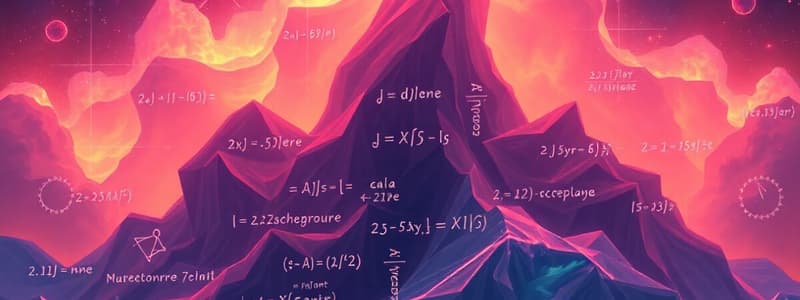Podcast
Questions and Answers
What characteristic of mathematical language allows it to express complex thoughts with relative ease?
What characteristic of mathematical language allows it to express complex thoughts with relative ease?
- Concise
- Precise
- Powerful (correct)
- Verbose
What is a characteristic of a unit set?
What is a characteristic of a unit set?
- It is always an infinite set.
- It must be an empty set.
- It contains only one element. (correct)
- It can contain multiple elements.
Which type of number includes both positive values and zero, but not fractions?
Which type of number includes both positive values and zero, but not fractions?
- Whole Numbers (correct)
- Natural Numbers
- Integers
- Rational Numbers
Which of the following sets can be classified as disjoint sets?
Which of the following sets can be classified as disjoint sets?
What is the mathematical term for a set that contains a countable number of elements?
What is the mathematical term for a set that contains a countable number of elements?
Which statement correctly describes equal sets?
Which statement correctly describes equal sets?
Which mathematical expression can represent an object, similar to how a noun functions in English?
Which mathematical expression can represent an object, similar to how a noun functions in English?
If set A is a proper subset of set B, what condition must be true?
If set A is a proper subset of set B, what condition must be true?
How is the number of subsets of a set determined?
How is the number of subsets of a set determined?
Which of these options is a characteristic of mathematical sentences?
Which of these options is a characteristic of mathematical sentences?
What is the correct notation for a set of natural numbers less than 11?
What is the correct notation for a set of natural numbers less than 11?
Which of the following numbers is considered irrational?
Which of the following numbers is considered irrational?
Which statement about expressions is true?
Which statement about expressions is true?
Flashcards are hidden until you start studying
Study Notes
Mathematics as a Language
- Mathematical language is characterized by precision, allowing for fine distinctions.
- It is concise, enabling brief expression of ideas.
- Mathematics is powerful in conveying complex concepts effectively.
Vocabulary vs. Sentences
- Nouns in English name people, places, and things.
- Sentences in English express complete thoughts.
- In mathematics, an Expression serves as the equivalent of a noun, labeling a mathematical object.
- Mathematical Sentences convey complete thoughts similar to English sentences.
Expressions and Mathematical Sentences
- Expressions have fewer symbols and operations, making them simpler for current use.
- Mathematical sentences can be read and always seek a truth value.
Synonyms and Verbs in Language
- Both English and mathematics can have multiple names for the same object.
- Verbs in English sentences correspond to mathematical operations; for example, the equation sign "=" acts as a verb in mathematics.
Types of Numbers
- Natural Numbers: Start from 1 and extend to infinity.
- Whole Numbers: Include natural numbers plus zero, without fractions.
- Integers: Whole numbers that can be positive, negative, or zero.
- Rational Numbers: Can be expressed as a fraction p/q; their decimal forms either terminate or repeat.
- Irrational Numbers: Cannot be expressed as a fraction; their decimal forms do not terminate or repeat.
- Real Numbers: Include all rational and irrational numbers.
- Sets: Defined as well-defined collections of distinct elements.
Notation for Sets
- Elements: Objects within a set.
- Common sets include:
- N: Natural Numbers
- W: Whole Numbers
- Z: Integers
- Q: Rational Numbers
- Q': Irrational Numbers
- R: Real Numbers
Writing a Set
- Tabular/Roster Form: Lists elements in braces, e.g., {1, 2, 3}.
- Set Builder Notation: Defines properties of its elements, e.g., A = {a | a ∈ N, a < 11}.
Types of Sets
- Finite Set: Contains a countable number of elements.
- Infinite Set: Lacks a definitive count of elements.
- Universal Set (U): The set containing all elements under consideration.
- Empty Set (∅): Contains no elements, represented as {} or ∅.
- Unit Set: Contains only one element.
- Equal Sets: Have identical elements, denoted A = B.
- Equivalent Sets: Have the same number of elements, denoted A ~ B.
- Joint Sets: Share at least one common element.
- Disjoint Sets: Have no common elements.
Subsets
- Improper Subset: All elements of set A are in set B, A = B.
- Proper Subset: All elements of set A are in set B, but B contains additional elements, A ⊂ B.
- Superset: A contains all elements of B, denoted A ⊇ B.
Power Set
- The power set P(A) is the set of all subsets of A.
- The number of subsets for a set with n elements is calculated as 2^n.
Studying That Suits You
Use AI to generate personalized quizzes and flashcards to suit your learning preferences.




